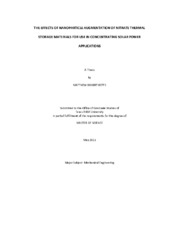| dc.contributor.advisor | Schuller, Michael | |
| dc.contributor.advisor | Lalk, Thomas | |
| dc.creator | Betts, Matthew | |
| dc.date.accessioned | 2011-08-08T22:48:30Z | |
| dc.date.accessioned | 2011-08-09T01:30:44Z | |
| dc.date.available | 2011-08-08T22:48:30Z | |
| dc.date.available | 2011-08-09T01:30:44Z | |
| dc.date.created | 2011-05 | |
| dc.date.issued | 2011-08-08 | |
| dc.date.submitted | May 2011 | |
| dc.identifier.uri | https://hdl.handle.net/1969.1/ETD-TAMU-2011-05-9118 | |
| dc.description.abstract | The Department of Energy funded a project to determine if the specific heat of thermal energy storage materials could be improved by adding nanoparticles. The standard thermal energy storage materials are molten salts. The chosen molten salt was a sodium nitrate and potassium nitrate eutectic, commercially called Hitec Solar Salt. Two nanoparticle types were chosen, alumina and silica. The nanoparticle composite materials were fabricated by mixing the components in an aqueous solution, mixing that solution for a set amount of time using a sonic mixer, then removing the water from the aqueous solution, leaving the composite molten salt behind as a fine white powder.
The thermal properties of the composite and plain material were measured using two techniques: American Society for Testing and Materials (ASTM) 1269E and Modulating Differential Scanning Calorimetry (MDSC). These two techniques measured the specific heat and the heat of fusion of the plain and composite materials.
The results of all the ASTM and MDSC measurements suggest that the addition of the nanoparticles using the given manufacturing technique increased the specific heat of the molten salt by approximately 20 percent, with both measurement techniques showing approximately the same level of increase. The silica and the alumina improved the specific heat by nearly the same amount over the base material. The heat of fusion did not seem to be significantly altered compared to the observed heat of fusion value of the unmodified material.
It was also observed that the nitrate and silica composite material's specific heat decreased if the material was raised to a temperature above 400C. The specific heat was observed to decrease over time, even when the temperature was well below 400C. It is unknown why this occurred. The nitrate plus alumina composite and the plain nitrate were stable to a temperature of 450C for the test duration. | en |
| dc.format.mimetype | application/pdf | |
| dc.language.iso | en_US | |
| dc.subject | Molten Salt | en |
| dc.subject | Concentrating Solar Power | en |
| dc.subject | Specific Heat | en |
| dc.subject | Nanoparticles | en |
| dc.subject | Differential Scanning Calorimetry | en |
| dc.subject | DSC | en |
| dc.subject | MDSC | en |
| dc.title | The Effects of Nanoparticle Augmentation of Nitrate Thermal Storage Materials for Use in Concentrating Solar Power Applications | en |
| dc.type | Thesis | en |
| thesis.degree.department | Mechanical Engineering | en |
| thesis.degree.discipline | Mechanical Engineering | en |
| thesis.degree.grantor | Texas A&M University | en |
| thesis.degree.name | Master of Science | en |
| thesis.degree.level | Masters | en |
| dc.contributor.committeeMember | Wen, Sy-Bor | |
| dc.type.genre | thesis | en |
| dc.type.material | text | en |


